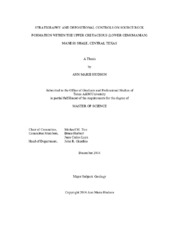| dc.description.abstract | With the success of the prolific Eagle Ford Shale play in South Texas, there is increasing interest in the resource potential of its equivalent source rock on the northeast side of the San Marcos Arch. The “Eagle Ford Shale” northeast of the San Marcos arch is composed of the transgressive lower Cenomanian Maness Shale, which unconformably overlies the Buda Limestone, and the regressive upper Cenomanian Pepper Shale of the Woodbine Group which unconformably underlies the Austin Chalk. This succession has sourced multiple reservoirs within the western portion of the East Texas Basin and is now being evaluated as a potential self-sourced reservoir. In this study we will attempt to determine the depositional controls on the formation of organic-rich source rock within the Maness Shale and divide the interval into chemostratigraphic packages based on whole rock elemental data. The main goals are 1) to build a depositional model within a sequence stratigraphic framework that can be used as a predictive tool to locate the richest source rocks within the basin, and 2) to determine the distribution of source rock facies vertically and laterally across the basin.
The Maness Shale is a mixed carbonate and siliciclastic mudrock which contains overall high TOC and was deposited in an anoxic, low-energy environment. Maximum TOC and carbonate content are found within a condensed section located in the upper portion of the Maness Shale in association with a maximum flooding surface. Paleo-redox elements (Cu, Ni, V, Mo, and U) indicate that maximum levels of anoxia were reached within the condensed section. Carbonate content is thought to be biogenic in origin and is a result of increased productivity within the basin. Increases in productivity also lead to a high amount of organic material being deposited and preserved. | en |


